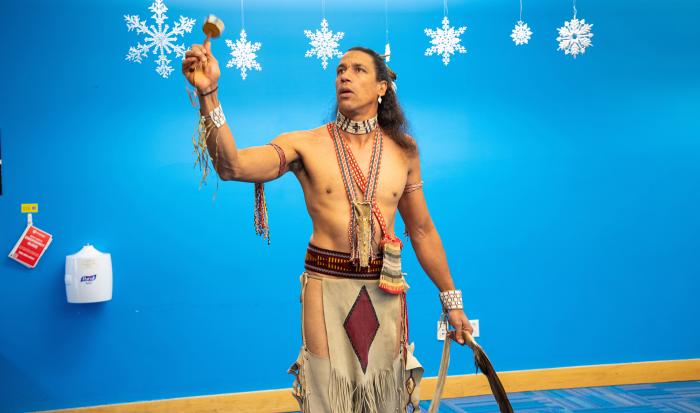
In a departure from his lecture format from 2022, Anawon Weeden visited QCC once again for Native American Heritage Month and gave an immersive portrayal of a Native American person interacting with European colonists. He started the presentation in what would have been the 1400s and only spoke to the audience in the native language of that time period, using hand gestures to communicate. He then invited several members of the audience to stand in a circle, hold hands and a perform a traditional dance.
Jumping to the early 1600s, Weeden included other languages such as French and English and offered the audience a place to rest and nourishment. After offering a fur pelt for trade, he alluded to how the Wampanoag people taught colonists to dig for quahogs and plant corn.
As he moved through time, Weeden's dress and demeanor changed, as did the relationship between Native Americans and colonists. By the mid-1600s Weeden was coughing and struggling to stand upright.
In the late 1600s, he displayed woven bracelets and belts that symbolized the intertwined stories of settlers and Native Americans such as Metacom, also known as King Philip, the son of Massasoit.
"My father, he did not just greet you, he welcomed you. He did not just welcome you, he protected you," said Weeden, acting as Metacom.
During the 1700s period, Weeden changed into jeans and a t-shirt and had a look of defeat as he spoke of being forbidden from dressing in his usual clothing and performing customs.
"I fear there will be no one left to tell our stories," Weeden said.
Finishing his portrayal with the 1800s, Weeden told the Wampanoag legend of Moshop, an ancient giant whose actions were said to have shaped the coastal areas of Massachusetts such as Nantucket and Noepe (Martha's Vineyard). He noted that this legend included aspects of a large white whale, which could have been the influence for Herman Mellville's "Moby Dick."
"This is America's history. You were not given the full story," Weeden continued.
After the presentation, Weeden was asked what more QCC can do to support Native American heritage. He commended the QCC land acknowledgment that is used at events but suggested that there's much more than can be done, such as commissioning a canoe burning, or the building of a shelter on campus. He also noted that the dance he performed with audience members during the presentation could be a form of land acknowledgement.
For more from Weeden, visit his Instagram @annawonw or firstlightfoundation.setmore.com.
